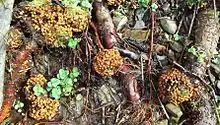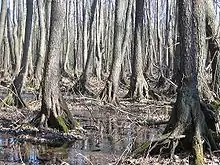Frankia alni
Frankia alni is a Gram-positive species of actinomycete filamentous bacterium that lives in symbiosis with actinorhizal plants in the genus Alnus. It is a nitrogen-fixing bacterium and forms nodules on the roots of alder trees.
| Frankia alni | |
|---|---|
 | |
| Nodules caused by Frankia alni on roots of common alder Alnus glutinosa | |
| Scientific classification | |
| Domain: | Bacteria |
| Phylum: | Actinomycetota |
| Class: | Actinomycetia |
| Order: | Frankiales |
| Family: | Frankiaceae |
| Genus: | Frankia |
| Species: | F. alni |
| Binomial name | |
| Frankia alni (Woronin 1866) Von Tubeuf 1895 | |
| Synonyms[1][2] | |
| |
Distribution
Frankia alni forms a symbiotic relationship exclusively with trees in the genus Alnus. These are widely distributed in temperate regions of the northern hemisphere. One species, Alnus glutinosa, is also found in Africa and another, the Andean alder, Alnus acuminata, extends down the mountainous spine of Central and South America as far as Argentina. Evidence suggests that this alder may have been exploited by the Incas and used to increase soil fertility and stabilize terrace soils in their upland farming systems.[3] Actinomycetota, like Frankia alni, need a flagellum to be mobile, but F. alni does not have one, and is immobile. Alnus species grow in a wide range of habitats that include glacial till, sand hills, the banks of water courses, bogs, dry volcanic lava flows and ash alluvium.[4]
Infection process
The first symptom of infection by Frankia alni is a branching and curling of the root hairs of the alder as the bacterium moves in. The bacterium becomes encapsulated with a material derived from the plant cell wall and remains outside the host's cell membrane.[5] The encapsulation membrane contains pectin, cellulose and hemicellulose.[6] Cell division is stimulated in the hypodermis and cortex, which leads to the formation of a "prenodule". The bacterium then migrates into the cortex of the root while the nodule continues to develop in the same way as a lateral root. Nodule lobe primordia develop in the pericycle, endodermis or cortex during the development of the prenodule and finally the bacterium enters the cells of these to infect the new nodule.[7]
Nitrogen fixation

In nitrogen-free culture and often in symbiosis, Frankia alni bacteria surround themselves in "vesicles". These are roughly spherical cellular structures that measure two to six millimetres in diameter and have a laminated lipid envelope. The vesicles serve to limit the diffusion of oxygen, thus assisting the reduction process that is catalysed by the enzyme nitrogenase. This enzyme bonds each atom of nitrogen to three hydrogen atoms, forming ammonia (NH3). The energy for the reaction is provided by the hydrolysis of Adenosine triphosphate (ATP). Two other enzymes are also involved in the process, glutamine synthetase and glutamate synthase. The final product of the reactions is glutamate, which is thus normally the most abundant free amino acid in the cell cytoplasm. A by-product of the process is gaseous hydrogen, one molecule of which is produced for every molecule of nitrogen reduced to ammonia, but the bacterium also contains the enzyme hydrogenase, which serves to prevent some of this energy being wasted. In the process, ATP is recovered and oxygen molecules serve as the final electron acceptor in the reaction, leading to the lowering of ambient oxygen levels. This is to the benefit of the nitrogenases, which only function anaerobically.[8]
As a result of their mutually beneficial relationship with Frankia, alder trees improve the fertility of the soils in which they grow and are considered to be a pioneer species, making the soil more fertile and thus enabling other successional species to become established.
Dispersal
In culture and in some root nodules, multilocular sporangia containing many spores are produced.[9] The sporangia are non-motile but the spores can migrate to infect new host plants.[10] A Swedish study found that root nodules developed on transplanted seedlings of the grey alder, Alnus incana, planted in meadow soil that had not grown actinorhizal plants for nearly sixty years. A similar experiment planting seedlings in deep layers of peat where the surface layer had been removed, did not produce nodulation. This seems to have been because there were no infective propagules of Frankia alna deep in the peat. No air-borne dispersal of Frankia alni was detected and it was thought that movement of water might account for the dispersal of the bacteria in peat soils.[11]
References
- Euzéby JP, Parte AC. "Frankia alni". List of Prokaryotic names with Standing in Nomenclature (LPSN). Retrieved May 12, 2022.
{{cite web}}: CS1 maint: uses authors parameter (link) - Becking JH. "Frankiaceae fam. nov. (Actinomycetales) with one new combination and six new species of the genus Frankia Brunchorst 1886, 174". Int J Syst Evol Microbiol. 20 (2). doi:10.1099/00207713-20-2-201.
- Krajick, K. (1998). "ARCHAEOLOGY: Green Farming by the Incas?". Science. 281 (5375): 322. doi:10.1126/science.281.5375.322. S2CID 140540246.
- Schwencke, J., and M. Caru. 2001. "Advances in actinorhizal symbiosis: Host plant-Frankia interactions, biology, and application in arid land reclamation. A review." Arid Land Res. Manag. 15:285-327.
- Lalonde, M., and A. Quispel. 1977. "Ultrastructural and immunological demonstration of the nodulation of the European Alnus glutinosa (L.) Gaertn. host plant by the North-American Alnus crispa var. mollis Fern. root nodule endophyte". Can. J. Microbiol. 23:1529-1547.
- Berg, R. H. 1990. "Cellulose and xylans in the interface capsule in symbiotic cells of actinorhizae". Protoplasma, 159:35-43.
- "Frankia infection process". Web.uconn.edu. Retrieved 2011-01-16.
- "Frankia nitrogen fixation". Web.uconn.edu. Retrieved 2011-01-16.
- Schwintzer, C. R., and J. D. Tjepkema (ed.). 1990. The Biology of Frankia and Actinorhizal Plants. Academic Press, Inc., New York.
- "Frankia sporangia". Web.uconn.edu. Retrieved 2011-01-16.
- Arveby, A.; Huss-Danell, K. (1988). "Presence and dispersal of infective Frankia in peat and meadow soils in Sweden". Biology and Fertility of Soils. 6. doi:10.1007/BF00257918. S2CID 45013932.